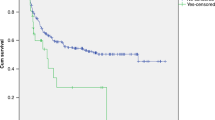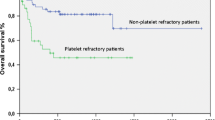Abstract
We retrospectively analyzed 60 cases of pediatric patients who received allogeneic stem cell transplantation (SCT) between 2000 and 2008, using the tentative scoring system for evaluation of early (<30 days) coagulation disorders. In the 41 patients who survived, d-dimer levels showed a transient increase 2 weeks after SCT and normalized thereafter, but these levels were persistently elevated in the 19 patients who died. Of 19 patients with a positive score, 11 died of transplantation-related complications [transplantation-related mortality (TRM) = 0.579] within 1 year, while none of the 41 with a negative score died during the same period. Since 2009, 12 of 30 patients had positive scores within 30 days after SCT. Intervention with recombinant human thrombomodulin (rhTM) was introduced for patients with a positive score, and 10 of these patients survived (TRM = 0.167) along with a dramatic improvement of d-dimer level. Although the effects of this treatment were observed in a limited number of patients, our observations suggest that early coagulation disorder after allogeneic SCT is a strong prognostic factor for TRM, and that intervention with rhTM improves TRM.





Similar content being viewed by others
Abbreviations
- rhTM:
-
Recombinant human thrombomodulin
- AT:
-
Antithrombin
- TMA:
-
Thrombotic microangiopathy
- VOD:
-
Veno-occlusive disease
- SCT:
-
Stem cell transplantation
- TRM:
-
Transplantation-related mortality
- SIRS:
-
Systemic inflammatory syndrome
- FDP:
-
Fibrin degradation products
- AML:
-
Acute myeloid leukemia
- ALL:
-
Acute lymphocytic leukemia
- CML:
-
Chronic myeloid leukemia
- SCID:
-
Severe combined immunodeficiency
- WAS:
-
Wiskott-Aldrich syndrome
- HIM:
-
Hyper IgM syndrome
- DKC:
-
Dyskeratosis congenita
- ID:
-
Immunodeficiency
- CAEBV:
-
Chronic active EB virus infection
- TBI:
-
Total body irradiation
- Bu:
-
Busulfan
- CY:
-
Cyclophosphamide
- ATG:
-
Anti-thymocyte globulin
- Flu:
-
Fludarabine
- LPAM:
-
Melphalan
- VP16:
-
Etoposide
- MSB:
-
Matched sibling bone marrow
- RMBM:
-
Related mismatched bone marrow
References
Carreras E. Veno-occlusive disease of the liver after hemopoietic cell transplantation. Eur J Haematol. 2000;64:281–91.
Bearman SJ. The syndrome of hepatic veno-occlusive disease after marrow transplantation. Blood. 1995;85:3005–20.
Uderzo C, Bonanomi S, Busca A, et al. Risk factors and severe outcome in thrombotic microangiopathy after allogeneic hematopoietic stem cell transplantation. Transplantation. 2006;82:638–44.
Batts ED, Lazarus HM. Diagnosis and treatment of transplantation-associated thrombotic microangiopathy: real progress or are we still waiting? Bone Marrow Transplant. 2007;40:709–19.
Cho BS, Min CK, Eom KS, et al. Clinical impact of thrombotic microangiopathy on the outcome of patients with acute graft-versus-host disease after allogeneic hematopoietic stem cell transplantation. Bone Marrow Transplant. 2008;41:813–20.
Ferrara JLM, Levine JE, Reddy P. Ernst Holler graft-versus-host disease. Lancet. 2009;373:1550–61.
Teshima T, Ordemann R, Reddy P, et al. Acute graft-versus-host disease does not require alloantigen expression on host epithelium. Nat Med. 2002;8(575–58):1.
Martin P, Bleyzac N, Souillet G, et al. Clinical and pharmacological risk factors for acute graft-versus-host disease after paediatric bone marrow transplantation from matched-sibling or unrelated donors. Bone Marrow Transplant. 2003;32:881–7.
Richardson PG, Soiffer PJ, Antin JH, et al. Defibrotide for the Treatment of severe hepatic veno-occlusive disease and multiorgan failure after stem cell transplantation: a multicenter, randomized, dose-finding trial. Biology Of Blood And Marrow Transplantation. 2010;16:1005–1017
Zhang L, Wang Y, Huang H. Defibrotide for the prevention of hepatic veno-occlusive disease after hematopoietic stem cell transplantation: a systematic review. Clin Transplant. 2012;26(511–51):9.
Ito T, Maruyama I. Thrombomodulin: protectorate God of the vasculature in thrombosis and inflammation Journal. Thromb Haemost. 2011;9:s168–73.
Van de Wouwer M, Collen D, Conway EM. Thrombomodulin-protein C-EPCR system integrated to regulate coagulation and inflammation. Arteriosclerosis thrombosis and vascular biology. 2004;24:1374–83
Abeyama K, Stern DM, Ito Y, et al. The N-terminal domain of thrombomodulin sequesters high-mobility group-B1 protein, a novel antiinflammatory mechanism. J Clin Investig. 2005;115(5):1267–74.
Ikezoe T, Takeuchi A, Isaka M, et al. Recombinant human soluble thrombomodulin safely and effectively rescues acute promyelocytic leukemia patients from disseminated intravascular coagulation. Leuk Res. 2012;36:1398–402.
Ogawa Y, Yamakawa K, Ogura H, et al. Recombinant human soluble thrombomodulin improves mortality and respiratory dysfunction in patients with severe sepsis. J Trauma Acute Care Surg. 2012;72:1150–7.
Kawano N, Yoshida S, Ono N, et al. Clinical features and outcomes of 35 disseminated intravascular coagulation cases treated with recombinant human soluble thrombomodulin at a single institution. J Clin Exp Hematopathol. 2011;51:101–7.
Aikawa N, Shimazaki S, Yasuhiro Y, et al. Thrombomodulin alfa in the treatment of infectious patients complicated by disseminated intravascular coagulation: subanalysis from the phase 3 trial. Shock. 2011;35(4):349–54,
Sawamura A, Hayakawa M, Gando S, et al. Application of the Japanese Association for Acute Medicine disseminated intravascular coagulation diagnostic criteria for patients at an early phase of trauma. Thromb Res. 2009;124:706–10.
Castor MGM, Rezende BM, Resende CB, et al. Platelet-activating factor receptor plays a role in the pathogenesis of graft-versus-host disease by regulating leukocyte recruitment, tissue injury, and lethality. J Leukoc Biol. 2012;91:629–39.
McDonald GB, Hinds MS, Fisher LD, et al. Veno-occlusive disease of the liver and multiorgan failure after bone marrow transplantation: a cohort study of 355 patients. Ann Intern Med. 1993;118:255–67.
Jones RJ, Lee KSK, Beschorner WE, et al. Venoocclusive disease of the liver following bone marrow transplantation. Transplantation. 1987;44(6):778–83.
Ho VT, Cutler C, Carter S, et al. Blood and marrow transplant clinical trials network toxicity committee consensus summary: thrombotic microangiopathy after hematopoietic stem cell transplantation. Biol Blood Marrow Transplant. 2005;11(571–57):5.
Ruutu T, Barosi G, Benjamin RJ, et al. Diagnostic criteria for hematopoietic stem cell transplant-associated microangiopathy: results of a consensus process by an International Working Group. Haematologica. 2007;92:95–100.
Bajzar L, Morser J, Nesheim M. TAFI, or plasma procarboxypeptidase B couples the coagulation and fibrinolytic cascades through the thrombin–thrombomodulin complex. J Biol Chem. 1996;271:16603–8.
Olivot JM, Estebanell E, Lafay M, et al. Thrombomodulin prolongs thrombin-induced extracellular signal-regulated kinase phosphorylation and nuclear retention in endothelial cells. Circ Res. 2001;88:681–7.
Meli R, Raso MG, Cicala C, et al. Thrombin and PAR-1 activating peptide increase iNOS expression in cytokine-stimulated C6 glioma cells. J Neurochem. 2001;79:556–63.
Griffin JH, Zlokovic BV, Mosnier LO. Protein C anticoagulant and cytoprotective pathways. Int J Hematol. 2012;95:333–45.
Ramasamy R, Yan SF, Schmidt AM. RAGE: therapeutic target and biomarker of the inflammatory response—the evidence mounts. J Leukoc Biol. 2009;86:505–12.
Yamagishi S. Advanced glycation end products and receptor-oxidative stress system in diabetic vascular complications. Ther Apher Dial. 2009;13(6):534–9.
Geiger H, Pawar SA, Kerschen EJ, et al. Pharmacological targeting of the thrombomodulin-activated protein C pathway mitigates radiation toxicity. Nat Med. 2012;18(7):1123–9.
Ikezoe T, Togitani K, Komatsu N, et al. Successful treatment of sinusoidal obstructive syndrome after hematopoietic stem cell transplantation with recombinant human soluble thrombomodulin. Bone Marrow Transplant. 2010;45:783–5.
Nakamura D, Yoshimitsu M, Kawada H, et al. Recombinant human soluble thrombomodulin for the treatment of hepatic sinusoidal obstructive syndrome post allogeneic hematopoietic SCT. Bone Marrow Transplant. 2012;47(3):463–4.
Inoue Y, Kosugi S, Miura I, et al. Successful treatment of refractory acute GVHD complicated by severe intestinal transplant-associated thrombotic microangiopathy using recombinant thrombomodulin. Thromb Res. 2011;127(6):603–4.
Ohwada C, Takeuchi M, Kawaguchi T, et al. Successful treatment with recombinant soluble thrombomodulin of two cases of sinusoidal obstructive syndrome/hepatic veno-occlusive disease after bone marrow transplantation. Am J Hematol. 2011;86(10):886–8.
Acknowledgments
This work was supported by a Grant-in-Aid from the Ministry of Education, Science, and Culture, Japan (MN) and the Japan Leukemia Research Fund (MN).
Conflict of interest
The authors have no conflicts of interest to declare.
Author information
Authors and Affiliations
Corresponding author
About this article
Cite this article
Nagasawa, M., Ohkawa, T., Endo, A. et al. Early coagulation disorder after allogeneic stem cell transplantation is a strong prognostic factor for transplantation-related mortality, and intervention with recombinant human thrombomodulin improves the outcome: a single-center experience. Int J Hematol 98, 533–542 (2013). https://doi.org/10.1007/s12185-013-1443-4
Received:
Revised:
Accepted:
Published:
Issue Date:
DOI: https://doi.org/10.1007/s12185-013-1443-4




